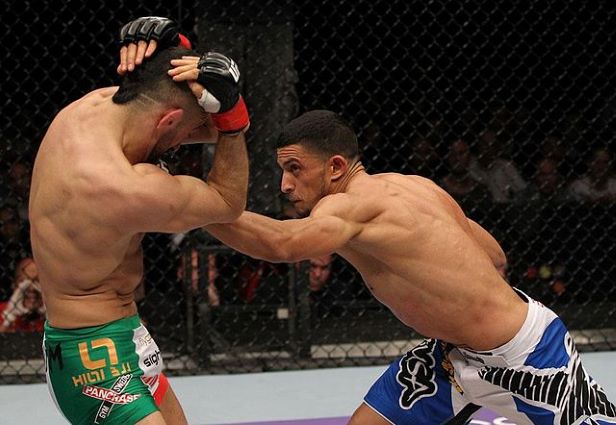
Are you wondering how often UFC fighters fight?
In this article, we’ll look at how often UFC fighters fight, the many reasons affecting how often they do so, and the fighters with the most UFC fights in a single year.
Contents
How Often Do UFC Fighters Fight?
UFC fighters fight on average every 3 to 6 months or 2 to 3 times per year. How often they fight is mostly determined by the UFC rankings and fighters can be split into three categories.
On average,
- UFC champions and top 5 fighters fight every 6 to 12 months or 1 to 2 times per year
- Middle-tier fighters fight every 3 to 6 months or 2 or 3 times per year, sometimes 4
- Lower-tier fighters fight every 3 to 4 months or 3 or 4 times per year, sometimes 5
UFC rankings are the main determinant of how often UFC fighters fight per year, but there are many other things affecting how often they fight, such as injuries, visa issues, contract disputes, weight-cutting issues, and compulsory medical suspensions.
Let’s take a look at all the reasons affecting how often UFC fighters fight.
UFC Rankings & Matchmaking
As mentioned above, UFC rankings by far determine how often UFC fighters fight. When a fighter first joins the UFC, most of the time they’re unknown and eager to compete as much as possible and make a name for themselves by moving up the rankings.
They’re also in a similar position to the majority of fighters who are outside the top 15, and therefore have a much larger pool of potential matchups.
In a fighter’s first 5 UFC fights, they have as many as 50 opponents in a particular weight division to compete against and their hunger to fight makes things happen.
However, as hungry to fight as they may be, the top 15-25 fighters have at least half the number of potential matchups and the UFC champions and top 5 fighters have even less.
Fighters in the top 25 who are winning, fight only fighters ahead of them, and those losing fight around their rank or just below it, acting as gatekeepers.
As an example, Khamzat Chimaev fought 4 times in 2018 and after joining the UFC in 2020, he fought 3 times in just over 2 months. Fast forward to August 2022, he’s fought only twice in the past 2 years.
After winning his third fight against Gerald Meershcaert, a gatekeeper, he needed a top 15 opponent in the welterweight division. Going from 50 potential matchups, he now has a maximum of 12 if you exclude the champion and two fighters vying to become the number one contender.
Injuries
The next factor affecting how often UFC fighters fight is injuries. In a sport where the aim is to hurt an opponent, it’s no surprise that injuries are a huge reason why fighters take a long time away from fighting to heal.
From broken bones to torn ligaments, deep lacerations, cauliflower ear, and the possibility of brain injuries, fighters can easily require a year or longer away from fighting.
Broken bones are injuries that keep fighters out for the longest time, and some examples are:
- Chris Weidman broke his leg on April 24, 2021, and over a year later he’s yet to return to the octagon because he requires another surgery after his leg was declared a nonunion
- Anderson Silva broke his leg on December 28, 2013, and it wasn’t until 13 months later on January 31, 2015, that he fought again
- After winning the heavyweight title, Frank Mir was involved in a serious motorcycle accident that left him out of the octagon for 20 months. Not only was he unable to fight, but he was also stripped of the heavyweight title. This goes to show that not all injuries happen inside the octagon
Even minor injuries like cauliflower ear or lacerations may mean a fighter is unable to fight for 6 months. They may require 2 months away from any training or sparring for the injury to heal, and they then need 2 to 3 months of training camp before they’re ready to fight again.
Because of the nature and mentality of fighters, they may continue training and therefore prevent injuries from healing, making matters worse and delaying their next fight further.
Overall, injuries affect all fighters but the top 15 fighters are less affected by injuries as they have the funds to pay for the best treatment and consultations regarding the healing process.
A huge factor causing a lot of fighters to fight less often and retire earlier as opposed to the early UFC fighters is CTE fears.
As more research is conducted, it’s looking likely that MMA is causing brain damage and long-term health issues for fighters; meaning fighters are fighting less often to allow their brains to fully heal after each fight.
Compulsory Medical Suspensions
Since the UFC adopted the Official Unified Rules of MMA in 2001, their fighters face medical suspensions after every event and must wait a minimum of 7 days before another fight.
Ringside physicians have the task to assess every fighter after each fight to decide whether suspensions are necessary and how long they should be.
The minimum suspensions are as follows:
| Injury | Minimum Suspension | Maximum Suspension or When Cleared by Doctor |
| None | 7 Days or 168 Hours | N/A |
| Choked Unconscious (Didn’t Tap) | 30 Days | N/A |
| Technical Knock Out (Referee Intervention) | 30 Days | N/A |
| Knock Out (Unconscious or Unable to Continue) | 45 Days | 90 Days |
| Facial Cut (Laceration) | 60 Days | Or When Cleared by Doctor |
| Limb or Joint Injury | 30 Days | 120 Days or When Cleared by Doctor |
| Broken Bone | 180 Days | or When Cleared by Doctor |
As can be seen above, if a fighter is left unconscious via submission or KO, or if they lose by TKO, they have a minimum suspension which gives them time to recover and be evaluated by another licensed medical doctor before they can fight again.
On the other hand, for facial cuts, limb or joint injury, and broken bones, there are minimum and maximum suspensions that can be avoided if cleared by a medical doctor at any time after the event.
For example, the ringside physician at a UFC event has issued a 120-day suspension for a limb or joint injury, but after 30 days the injury has healed well. The fighter can now fight again sooner if they receive clearance from a medical doctor.
Weight Cutting Issues
Weight cutting is the process of losing body fat and more specifically, dropping water weight in the week before a fight in order to gain a size and power advantage by weighing in much less than their weight when fighting.
Weight cutting affects how often UFC fighters fight because it’s considered the ‘fight before the fight’ and can cause fighters many health issues and therefore render them unable to fight.
Weight cutting is dangerous and has caused various MMA deaths, even prompting One FC to ban weight cutting after the death of one of their fighters in 2015.
In the UFC there have been many high-profile issues caused by weight cuts, such as:
- Khabib Nurmagomedov – In 2017 before an interim title fight with Tony Ferguson, Khabib was rushed to hospital and pulled from the fight after being extremely dehydrated, suffering kidney pain and memory problems
- Darren Till – In 2018 before his fight against Stephen Thompson, Till experienced temporary blindness while on a treadmill and his team had to continually pick him up during the latter stages of the weight cut
If weight cutting causes a fighter to pull from the fight, it also means their opponent is likely to miss the fight as it’s too late to get a replacement. In some situations, the UFC has a replacement, but this is usually reserved for title fights.
In Till’s case, he missed weight by 3.5 lbs but Stephen Thompson accepted the catchweight bout because if not, he’d have missed the fight too.
Not only does weight cutting cause fights to be canceled, but fighters also need time to recover from the weight cut after the fight.
This means that big fighters who drop 20+ lbs before every fight are more likely to fight less often than fighters who don’t drop as much weight and therefore aren’t putting their bodies and minds under such stress. It’s highly unlikely to see a UFC fighter perform more than three big weight cuts in a year.
Elite-level fighters are more likely to perform more extreme weight cuts than lower-ranked fighters because they’re looking for every advantage possible in a sport of fine margins.
Therefore, weight cutting affects higher-ranked fighters more so in terms of how often they fight because they need more recovery time.
Contract Disputes & Refusals to Fight
Contract disputes between fighters and the UFC hierarchy can affect how often they fight. Contract disputes are often related to fighter pay and have led to many fighters refusing to fight, despite having fights left on their current contract.
UFC fighters are all independent contractors, so they have the right to refuse a fight and also to renegotiate contracts. Because of this, fights can take a while to negotiate, especially if a fighter feels they’re getting the short end of the stick.
Fighters also refuse to fight at times because they feel their opponent is unworthy of a fight and that they’d not get closer to a title fight by beating them.
This infamously occurred when Jon Jones refused to fight Chael Sonnen on late notice after his original opponent, Dan Henderson, was ruled out through injury. The refusal meant UFC 151 was canceled and delayed; the first time in UFC history a PPV event was canceled under the Zuffa era.
Money
Similar to contract disputes, money has an effect on how often UFC fighters fight.
Lower-ranked and middle-tier fighters earn between $10,000 to $30,000 to show, and $10,000 to $30,000 to win. With these numbers, it’s easy to see how a fighter may want to fight 3 or more times per year.
On the other hand, UFC champions and popular and experienced UFC fighters earn a lot more. The 11 biggest UFC earners took home between $932,000 and $8 million in 2021, without even considering PPV points which is where the real money is made for the UFC’s biggest stars.
Based on these numbers it’s clear how well-paid athletes would fight less often, once or twice per year, because they’re not in need of money and are choosing to fight at their most optimal condition.
In contrast, lower-tier fighters are fighting at every opportunity to make more money and scale the rankings, but are at a higher risk of injuries and losses by not giving themselves enough time to recover or prepare.
Lack of PPV events
While there are critics who say the UFC produces too many PPV events, UFC champions would argue there aren’t enough because they’re the events they fight at.
How often top fighters fight, and more specifically the champions, is restricted by the amount of PPV events per year. On average, there are 12 PPV events per year and there are potentially 12 UFC champions, one for each weight class division.
While they could fight three times a year as there aren’t any rules against it, the majority of UFC champions fight once or twice per year as there simply aren’t enough PPV events for the majority to fight more than this. Combined with all the above factors, champions are fighting less frequently than ever.
Visa Issues
The UFC is an American promotion and the majority of events take place in America. Because of this, at times international fighters are unable to get visas permitting them to enter the country to fight.
This was especially true in 2020 and somewhat in 2021 during the height of the covid pandemic when borders were closed and fighters were unable to travel even if they had the necessary work visas.
Outside of the pandemic, the UFC often obtains P-1 visas for their athletes, but only for events in America for which the fighter has a fight. For events outside of the US, fighters have to source their own work visas and can have trouble doing so.
The main problem in obtaining the visa is the time taken. Fighters have been unable to make an event because the visa processing time takes too long, despite applying for the visa at the first opportunity. It can take months or even years for a fighter to get a visa, or even get an interview.
Other visa issues that have kept fighters from not fighting at the proposed date are visa issues for their team.
The UFC only obtain P-1 visas for the fighters, so their team has to obtain work visas themselves which can cause problems; especially for new fighters who haven’t flown to America or outside their home country before.
Personal Time Out
Fighters may fight less often because of a personal time out away from the sport. This may be for various reasons such as family issues, building business outside of the UFC, or simply taking a necessary break so they come back stronger and more skilled than before.
Who Had the Most UFC Fights in a Year?
Since the UFC’s inception in 1993, the record for most UFC fights in a single year is held by 10 fighters who’ve fought 5 times in a single year. Here’s a list of those fighters:
- Chris Leben – 5 fights in 2006
- Roger Huerta -5 fights in 2007
- Donald Cerrone – 5 fights in 2011
- Daron Cruickshank – 5 fights in 2014
- Neil Magny – 5 fights in 2014 and in 2015
- Uriah Hall – 5 fights in 2015
- Ross Pearson – 5 fights in 2016
- Thiago Santos – 5 fights in 2018
- Greg Hardy 5 – fights in 2019
- Kevin Holland – 5 fights in 2020
While there wasn’t a UFC fighter to have 5 fights in the 2021 calendar year, Ciryl Gane had 5 fights in 13 months (December 2020 – January 2022) which is the closest a fighter came.
Most impressive here is Neil Magny, who had 10 UFC fights in 2 years and this is why he has the most fights in UFC welterweight history. He also won all 5 fights in 2014 and 4 out 5 in 2015.
It’s also no surprise to see Donald Cerrone on this list, who is joint-second for the most fights in UFC history.
Neil Magny, Donald Cerrone, and Kevin Holland are the only UFC fighters to have won all 5 fights in one year.
On average, these 10 athletes fought every 2 months and managed to do so because they were injury free and hungry to climb the UFC rankings.
How Soon Can UFC Fighters Fight Again?
As mentioned earlier, the only thing officially keeping UFC fighters from fighting again is the compulsory medical suspensions. All UFC fighters must wait a minimum of 7 days before another fight, meaning a fighter can fight at the very next event.
In 2020, Khamzat Chimaev broke the UFC record for the three quickest consecutive wins which he did in 66 days between July 15 and September 19.
His first two fights were won and fought in just 10 days, but the record for the quickest turnaround is held by Loopy Godinez who had only 7 days between fights in 2021.
She fought on October 9 and on October 16, meaning she immediately fought after serving the compulsory minimum 7 days suspension.
The Bottom Line
So, ‘how often do UFC fighters fight’?
UFC fighters fight on average every 3 to 6 months or 2 to 3 times per year. How often they fight is mostly determined by the UFC rankings and fighters can be split into three categories.
On average,
- UFC champions and top 5 fighters fight every 6 to 12 months or 1 to 2 times per year
- Middle-tier fighters fight every 3 to 6 months or 2 or 3 times per year, sometimes 4
- Lower-tier fighters fight every 3 to 4 months or 3 or 4 times per year, sometimes 5
Overall, as discussed in this article there are many factors affecting how often UFC fighters fight, but the most determinant is UFC rankings, injuries, and compulsory medical suspensions.




